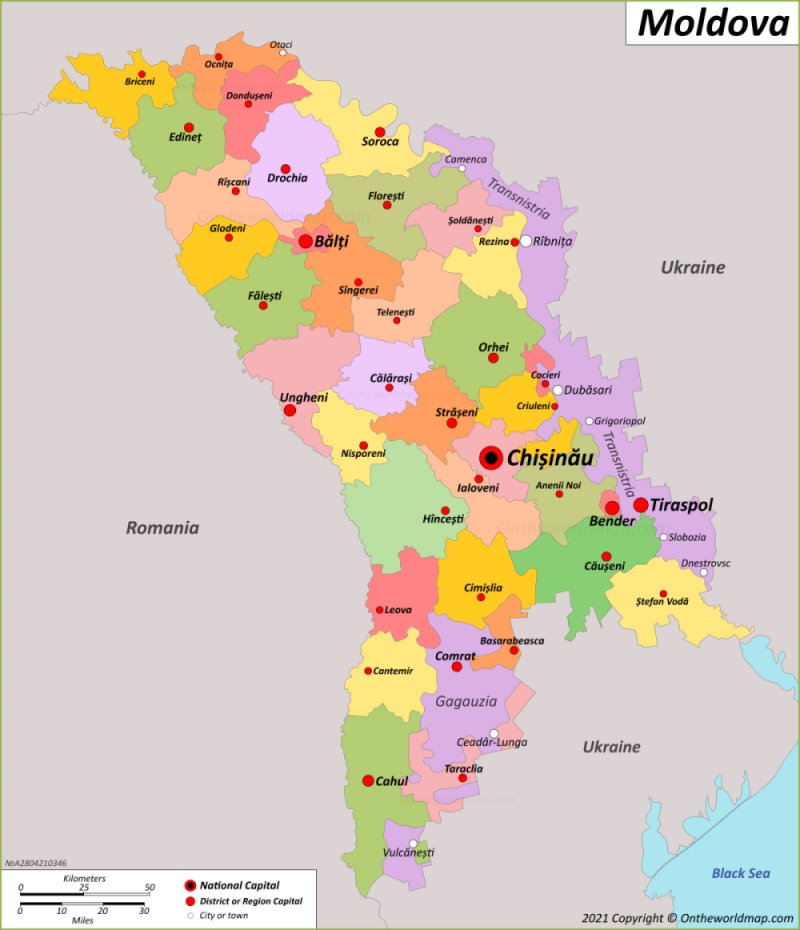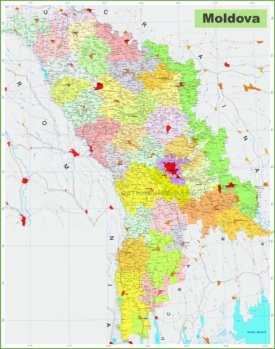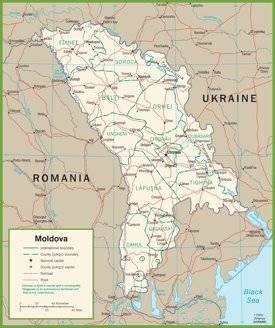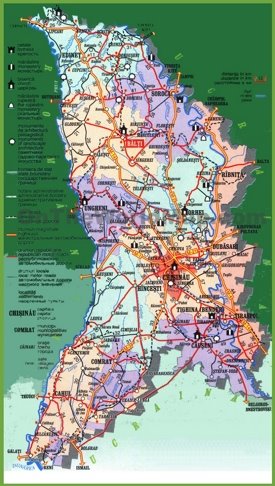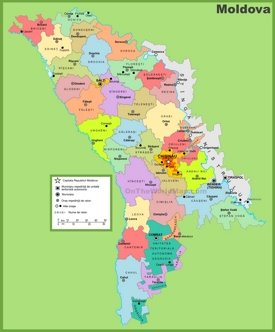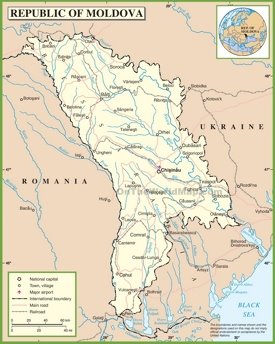Moldova Map
Description:
This map shows governmental boundaries of countries, districts, autonomous regions, district capital cities, major cities and towns in Moldova.
Size: 1400x1626px / 498 Kb
Author: Ontheworldmap.com
You may download, print or use the above map for educational, personal and non-commercial purposes. Attribution is required. For any website, blog, scientific research or e-book, you must place a hyperlink (to this page) with an attribution next to the image used.
Online Map of Moldova
Detailed Maps of Moldova
About Moldova
Moldova is a landlocked country in the northeastern part of the Balkan Peninsula, in Eastern Europe. Moldova borders Ukraine to the north, east, and south, Romania to the west. The unrecognized breakaway state of Transnistria (internationally recognized as part of Moldova) lies across the Dniester River on the country's eastern border with Ukraine. The country has an area of 33,843 square kilometers (13,067 square mile) and a population of about 2. 45 million people. Moldova is a unitary parliamentary representative democratic republic.
Chișinău is the capital and largest city of the country, as well as the main cultural and commercial center of the country. Other significant cities include Bălți, an important industrial hub, Bender, Rîbnița, and Tiraspol, located in the region of Transnistria.
Moldova's economy relies heavily on agriculture, in which winemaking plays an important role. The country produces and exports a significant amount of wine, taking advantage of its fertile soils and favorable climate. Remittances from Moldovans working abroad (mainly in the European Union and Russia) also contribute significantly to the national economy. In addition, Moldova is working to develop its industrial sector and attract foreign investment to diversify its economic base.
Moldova faces challenges such as political instability and economic dependence on external factors, including energy imports. The country continues to undertake reforms and strengthen ties with the European Union to improve its economic prospects and governance.
The Facts:| Capital: | Chișinău |
| Area: | 13,067 sq mi (33,843 sq km) |
| Population (2024): | ~ 2,423,300[1] |
| Official language: | Romanian (Moldovan) |
| Currency: | Moldovan leu (MDL) |
| Driving side: | right |
| Calling code: | +373 |
| Internet TLD: | .md |
| Time zone: | UTC+2 (EET) Summer (DST) UTC+3 (EEST) |
| Gross domestic product 2024 (PPP): |
|
| Gross domestic product 2024 (nominal): |
|
Largest Cities: Chișinău, Tiraspol, Bălți, Bender, Rîbnița, Ungheni, Cahul, Soroca, Orhei, Dubăsari, Comrat, Strășeni, Durlești, Ceadîr-Lunga, Căușeni.
Districts, municipalities and autonomous territorial units of Moldova: Anenii Noi, Basarabeasca, Briceni, Cahul, Cantemir, Călărași, Căușeni, Cimișlia, Criuleni, Dondușeni, Drochia, Dubăsari, Edineț, Fălești, Florești, Glodeni, Hîncești, Ialoveni, Leova, Nisporeni, Ocnița, Orhei, Rezina, Rîșcani, Sîngerei, Soroca, Strășeni, Șoldănești, Ștefan Vodă, Taraclia, Telenești, Ungheni, Chișinău, Bălți, Bender, Gagauzia, Transnistria.
Geography of Moldova
Moldova has a predominantly hilly terrain with rolling plains and the Dniester River forming part of its eastern border. The country lacks significant natural barriers, which accounts for its open landscape. Moldova has a temperate continental climate characterized by warm summers and cold winters. Average temperatures range from -4°C (25°F) in January to 20°C (68°F) in July.
The country is divided into several geographic regions, including the Central Moldavian Plateau, the Northern Moldavian Plateau, and the Southern Bessarabian Plain. These regions are home to a variety of agricultural activities, aided by fertile black earth soils. The climate and soils are conducive to the cultivation of crops such as grapes, sunflowers and wheat, and viticulture plays an important role in the country's economy.
Brief History of Moldova
The Principality of Moldavia emerged in the 14th century, laying the foundation for the region's identity. Over the centuries, Moldavia has been under pressure from neighboring powers, including the Ottoman Empire, which exercised suzerainty over the principality from the 16th to the 19th centuries.
In 1812, the Russian Empire annexed the eastern part of Moldavia, known as Bessarabia, as a result of the Russo-Turkish War. After World War I, Bessarabia united with Romania, but the Soviet Union reoccupied the territory in 1940, forming the Moldavian Soviet Socialist Republic. Moldova declared independence from the Soviet Union in 1991, after its dissolution.
In the post-independence period, Moldova has faced economic problems and political instability. The unresolved Transnistrian conflict over the self-declared independent region in eastern Moldova continues to influence the country's political landscape. Moldova seeks closer ties with the European Union while balancing on the edge of relations with Russia, reflecting its strategic geopolitical position.

